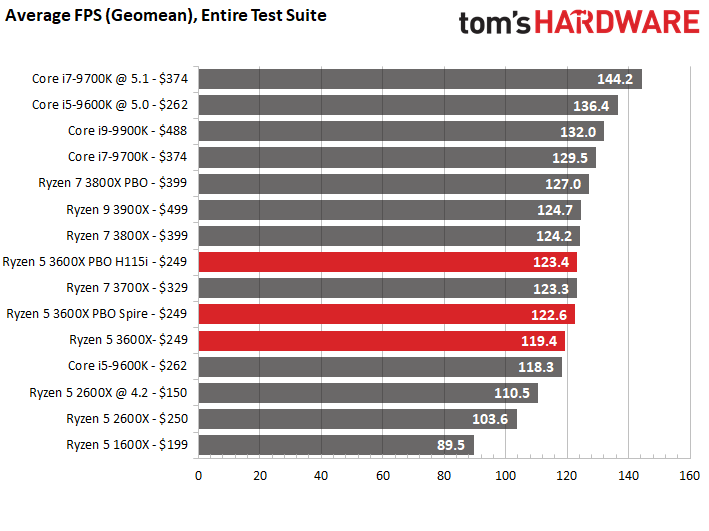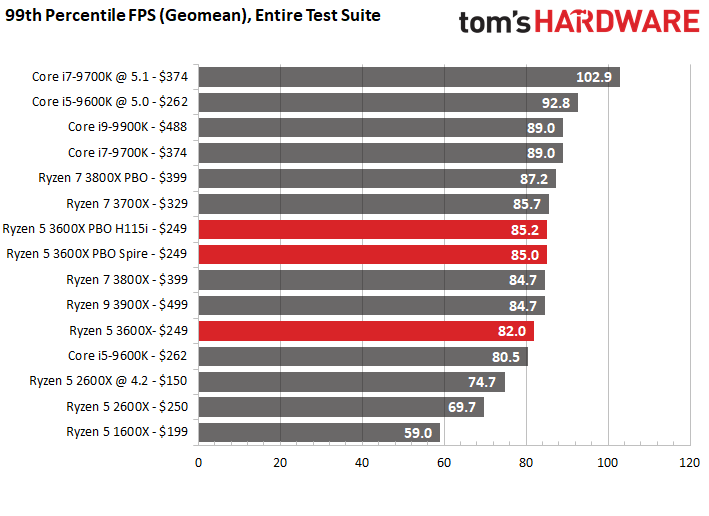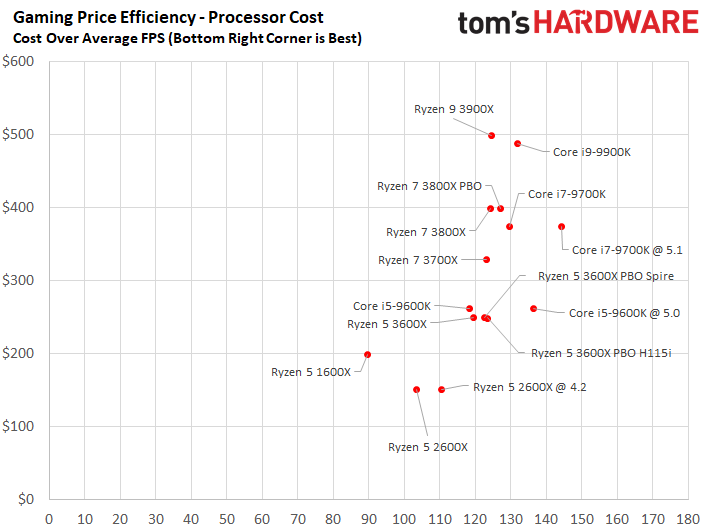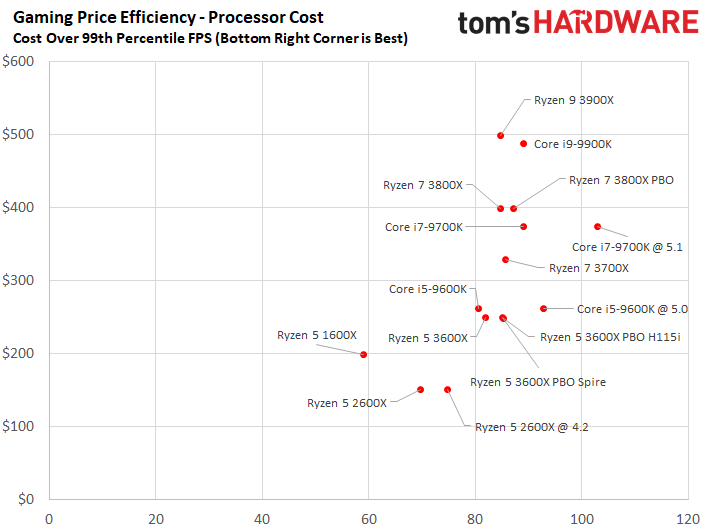AMD Ryzen 5 3600X Review: the New Mid-Range CPU Leader
Why you can trust Tom's Hardware
Conclusion
Out of the box, the Ryzen 5 3600X is the best processor in its price range for gaming and productivity, marking a massive shift in the mid-range. At stock settings, the Ryzen 5 3600X regularly beat the more expensive Core i5-9600K in both categories, albeit by slim margins in gaming, reversing the long-held trend of Ryzen being best for productivity while Intel ruled the gaming roost. If you're into overclocking, the Intel processors are going to deliver more performance, but the majority of enthusiasts looking for a set-it-and-forget-it processor will find incredible value in the Ryzen 5 3600X.
In the chart below, we plot gaming performance with both average frame rates and a geometric mean of the 99th percentile frame times (a good indicator of smoothness). It's worth noting that AMD's previous-gen line-up is heavily discounted, so we’re departing from our standard practice of using official price lists. Instead, we’re using average pricing found online (temporary sales excluded). Volatility applies.




After a few years of staring at gaming value charts that always show Intel in the leadership position, it jumps right off the page that the stock Ryzen 5 3600X topples the Intel Core i5-9600K. The difference is slight in average framerates, a mere 1.1 FPS, but widens to 2.5 FPS in 99th percentile metrics, indicating the 3600X also offers a smoother gaming experience. While these deltas are small and likely imperceptible to casual users, especially when these chips are paired with mid-range graphics cards or higher-resolutions, there's no understating the impact. Intel does take the uncontested lead after overclocking, so overclocking enthusiasts will still flock to those processors for the ultimate gaming performance, but the Ryzen 5 3600X is the new king of the mid-range for the majority of gamers.
The -9600K can't compete with the 3600X in many threaded applications, like rendering, even after overclocking. Pairing the 3600X's slightly better gaming performance with its overwhelming advantage in threaded productivity apps seals the deal.
But there are two elephants in the room. Firstly, not all Ryzen models are hitting their rated boost clock rates. This boils down to several factors, including motherboard firmwares that will hopefully improve, and how enthusiasts measure clock rates. We measured clock rates at a 100ms granularity and found that, unlike what we've seen with the Ryzen 9 3900X, the Ryzen 5 3600X does achieve its rated clock speeds. There are a few caveats associated with that, which we'll dive into deeper in a follow-up piece.
Overclocking performance is also another concern for enthusiasts. The previous-gen Ryzen models were never known for their overclocking prowess, but more often than not, you could eke out some decent performance gains via manual tuning. Outside of a few edge use-cases, those days are over. Now it's best to stick with AMD's automated PBO overclocking feature, and you shouldn't expect massive gains. It seems that AMD is extracting the best performance it can from the 7nm process at stock clocks, so there is precious little overhead left to exploit. Intel does offer higher overclocking capability, and that will continue to be attractive to enthusiasts chasing that last frame per second in their favorite titles.
AMD's PBO does give some slight performance gains, and the company says that better cooling can extract better performance. We found that to be true, but the bundled (i.e., 'free') Wraith Spire cooler offers the lion's share of the benefits of PBO, and with no additional investments. As you can see in the gaming performance charts above, a beefy $140 liquid cooler with dual 140mm fans cranking away at full speed extracted an additional 0.8 FPS in average gaming performance and 0.2 FPS in 99th percentile measurements. The beefier cooler did give us slightly larger gains in some heavily-threaded applications, but the basic rule still holds: The Wraith Spire will give you 90-95% of the performance of PBO with no additional investment. There are other reasons to go with a better cooler, such as aesthetics or acoustics. However, if your sole objective is to extract more performance, that money is best spent on other additives, like a better GPU or a new PCIe 4.0 SSD.
Get Tom's Hardware's best news and in-depth reviews, straight to your inbox.
The ability to even use a PCIe 4.0 device at its full performance is an advantage that Intel simply can't match. Unfortunately, the faster interface does result in higher-priced X570 motherboards, but AMD's continued support for the X470 motherboard ecosystem could help blunt the blow. Motherboard partners continue to offer X470 motherboards, and they are cheap and plentiful. You'll lose access to the PCIe 4.0 interface in exchange for lower pricing, at least officially, but you'll also have a compelling upgrade path in the future.
Our only hesitation with recommending the 3600X comes from competition within AMD's own stable. After overclocking, AMD's non-X models, like the Ryzen 5 3600, often offer the same level of performance as their more-expensive counterparts. That means the 3600 looks like a great chip (from afar) that will offer similar performance at a $50 savings. We'll have that part in for testing soon.
With all of Ryzen 5 3600X's advantages, aside from higher overclocking ceilings or integrated graphics, there are very few reasons to buy a competing Intel processor in this price range. The Ryzen 5 3600X has stolen the mid-range crown from Intel.
Image Credits: Tom's Hardware
MORE: Best CPUs
MORE: Intel & AMD Processor Hierarchy
MORE: All CPUs Content
Current page: Conclusion
Prev Page Rendering, Encoding, Compression, Encryption, AVX
Paul Alcorn is the Editor-in-Chief for Tom's Hardware US. He also writes news and reviews on CPUs, storage, and enterprise hardware.
-
DookieDraws Reply
Shhhhhhhh. You're going to get everyone to buy one at that time and possibly screw us up from getting one. :p However, you can grab one through Google's store right now and save $20 off the price by applying their promo code. I'm just not ready right now.SgtScream said:The regular 3600 is going to be an absolute steal for black friday deals. -
Gurg You are really trying way too hard in your AMD sales pitch. Seriously how many gaming enthusiasts buy their CPUs at Walmart especially when its prices are $17 higher than Amazon? Amazon 3600x costs a McDonald's double quarter pounder more than the the 9600k. As for competitive pricing, my local Microcenter sells the 9600k for $219.99.Reply
The overclocked and similarly cooled 9600k shows a 10.5% advantage in average gaming FPS and an 11.5% FPS advantage in 99th percentile gaming FPS over the 3600z. Even more the OC 9600k also whips the 3900x, 3800x and 3700x by convincing margins. Note the AMD cpus also lack igpus. In the value charts you used the three double quarter pounder and diet cokes higher Walmart pricing for the 9600k rather than Amazon to make a value basis for 3600x.
If your emphasis is not gaming or MS Office but rather workstation usage then the 3600x should be recommended. Why would anyone not planning on overclocking and at strictly value bother to buy pay extra for an X or K? If the 3600x is the new gaming king---the king has no clothing. -
TCA_ChinChin You know it's good when people start accusing Tom's of being AMD shills when usually people call them Intel shills. I'll agree with @Gurg in that the i5-9600k is still better in gaming against Ryzen 3000 in many cases though so calling 3600x the winner in gaming (against the i5-9600k) is a stretching it a little. The difference is now small enough that the extra cores are probably worth more to the average buyer than the increased FPS the 9600k offers, NOT because Ryzen 3600x is strictly better in gaming.Reply -
AlistairAB ReplyGurg said:You are really trying way too hard in your AMD sales pitch. Seriously how many gaming enthusiasts buy their CPUs at Walmart especially when its prices are $17 higher than Amazon? Amazon 3600x costs a McDonald's double quarter pounder more than the the 9600k. As for competitive pricing, my local Microcenter sells the 9600k for $219.99.
The overclocked and similarly cooled 9600k shows a 10.5% advantage in average gaming FPS and an 11.5% FPS advantage in 99th percentile gaming FPS over the 3600z. Even more the OC 9600k also whips the 3900x, 3800x and 3700x by convincing margins. Note the AMD cpus also lack igpus. In the value charts you used the three double quarter pounder and diet cokes higher Walmart pricing for the 9600k rather than Amazon to make a value basis for 3600x.
If your emphasis is not gaming or MS Office but rather workstation usage then the 3600x should be recommended. Why would anyone not planning on overclocking and at strictly value bother to buy pay extra for an X or K? If the 3600x is the new gaming king---the king has no clothing.
With a 2080 ti at 1080p and an OC for the 9600k you might get 4 percent better avg fps. With a 2080 at 1440p? Exactly the same FPS. For the same price you'll buy the 3600x and a 2060 and easily beat the 9600k and a 1660 ti by 25%. The Spire Cooler is included with the AMD CPU, and that's the good one, and you can use a cheap motherboard also. The whole computer industry is kind of ridiculous that you even need to explain to people why the 3600x is better when it is so obvious. -
DavidDisciple ReplyGurg said:Even more the OC 9600k also whips the 3900x, 3800x and 3700x by convincing margins.
Notice you said OC 9600K. Isn't it something that a 3rd generation Ryzen is on par and sometimes defeating a 9th generation Intel chip insomuch that you have to overclock it to compete with a 3rd generation Ryzen at stock speed. That says a lot about how good Ryzen's architecture is compared to 9 generations of Intel. The Ryzen architecture is so well refined now that there isn't much overclocking room to begin with. I am not an overclocker to begin with and don't want to overclock contrary to your belief that everyone plans to do it. If I buy a high performance chip to begin with, why would I need to do it? If I need to overclock my chip to compete against others, obviously I didn't buy a competitive chip out-of-the-box to begin with or my chip is inferior in architecture. -
SethNW Midrange CPU king? Only reason you can say that is because you haven't tested 3600, if you did you would learn that is is about 1-2% slower than 3600X and last time I checked, paying good 50USD extra isn't worth that small uplift. And reason for this is in Percision Boost, which will boost CPU based on temperature and power headroom. Keeping two CPUs really close. And better cooler just isn't worth it with 3600X. So I am not sure if this was done to bait clicks or if it was done to sell clicks of affiliate links of more expensive item. But what I can say for sure, it definitely wasn't done for good of the reader. Sorry, but you will see when you review 3600.Reply -
Gurg ReplyAlistairAB said:With a 2080 ti at 1080p and an OC for the 9600k you might get 4 percent better avg fps.
TH tested with a 2080ti @ 1080p and the Conclusion chart showed an average gaming fps of 136.4 vs 123.4 a 10.53% difference between OC 9600k and PBO OC 3600x, both using the same h115i closed loop cooler. If the 3600x is using the spire cooler the difference goes to 11.26%. -
djayjp Anybody buying less than 8c/16t for gaming is a fool--next gen consoles will have this (will basically be a 3700x at 65W) so this will become the new minimum requirement.Reply -
SgtScream Reply
Dude relax. Not everyone can afford an 8 core 16 thread chip and that doesn't make them a fool.djayjp said:Anybody buying less than 8c/16t for gaming is a fool--next gen consoles will have this (will basically be a 3700x at 65W) so this will become the new minimum requirement.